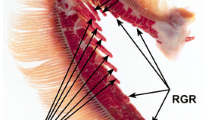Abstract
THE largest known species of Enteropneusta was discovered by Fritz Müller on the Brazilian coast, at a place named Armação da Piedade, in the State of Santa Catarina. Fritz Müller's notes in which he describes the animal were fortunately collected and published in the year 18981 by Dr. Hermann von Ihering, former director of the Museu Paulista of São Paulo. In those notes (p. 36), Fr. Müller said that he caught many tornaria larvæ from 1860 onwards in the plankton off the same beach. The first Balanoglossus was captured in 1884, and in the following year many others were caught. The extraordinary size of the animals (1.5 m. in length) justified the name Balanoglossus gigas. Some of the specimens were sent to Spengel2, who gave them in 1893 a new description and re-named them Ptychodera gigas. In a later monograph on the Hemichordata, recently published, van der Horst3 re-described the same animal under the name of Balanoglossus gigas Fr. Müller.
Similar content being viewed by others
References
Müller, Fr., Observações sobre a fauna marinha, Rev. Mus. Paulista, 3, 35 (1898).
Spengel, J. W., “Die Enteropneusten des Golfes von Neapel.”, 159 (1893).
van der Horst, C. J., Bronns Tierreichs, 4, No. 4, 717 (1939).
Author information
Authors and Affiliations
Rights and permissions
About this article
Cite this article
SAWAYA, P. Balanoglossus gigas Fr. Müller rediscovered on the Brazilian Coast. Nature 167, 730–731 (1951). https://doi.org/10.1038/167730b0
Issue Date:
DOI: https://doi.org/10.1038/167730b0
- Springer Nature Limited
This article is cited by
-
Another Giant Enteropneust from the Atlantic
Nature (1964)





